SUMMARY
This is AI generated summarization, which may have errors. For context, always refer to the full article.

SINGAPORE – “In Singapore, you never go hungry.”
One of my cab drivers said that, and he speaks truth. Singapore, or “Little Red Dot,” as it is fondly known, is only around 718 sq. km, yet you’re spoiled for choice, from haute cuisine to hawker food. (READ: First time in Singapore? 12 places to visit)
Anthony Bourdain once said in a Singapore episode of No Reservations, “Imagine a perfect world where fast food is good food, where food is everywhere – the best of Indian, Malay, Chinese…” Indeed, delights await in every corner – from the time you land at Changi Airport, to the city center, all the way to the suburban housing estates.

The Lion City is a cosmopolis, a coming together of various cultures and races, thanks to its geography. Strategically located at the tip of the Malaysian peninsula, Singapore served as a trading outpost for the ancient Srivijayan Empire centered on the Indonesian island of Sumatra.
The British Empire also saw its potential as Sir Stamford Raffles established it as a port for free trade in 1819. Merchants and migrants came – from China, India, Indonesia, the Malay Peninsula, and the Middle East.
The Singapore we know today was established as a sovereign nation on August 9, 1965. The city-state, led by the vision of founding prime minister Lee Kwan Yew and its industrious pioneering citizens made up of four ethnic groups – Chinese, Malays, Indians, and Eurasians – has been on the rise ever since. Singapore marks its 50th year of independence this 2015.
Naturally, this history and geography reflects on Singaporean gastronomy, which makes the Little Red Dot anything but a blip on the world culinary map.
Although these dishes are by no means representative or exhaustive of the culinary landscape here, we can still glean some history lessons. Through these dishes, you can discover Singapore’s heritage and cultural diversity as a result of huge waves of migration. You can also see how it has gained its status as a truly global and cosmopolitan nation.
I
A coming together of cultures
Satay
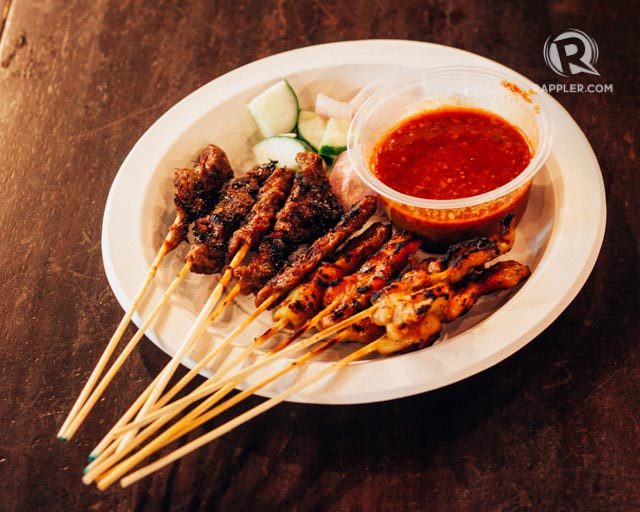
Legend has it that when the Srivijayan prince Sang Nila Utama visited the island of Temasek,(“Sea Town”) as Singapore was known back then, and hunted there, he spotted an animal resembling a lion. He took it as a good omen, and on it, he established Singapura, the “Lion City,” from the Sanskrit words singha and pura, in 1324.
Since that time, 5 Malay kings have ruled the city – its history punctuated by several dynastic and colonial power struggles. Following a treaty with the British establishing the city as a port for the Empire’s merchant fleet, it became the center of government for the Straits Settlements which attracted immigrants around the region – including Malays from the Malaysian peninsula up north and from neighboring Indonesia.
“Malay,” is sort of a catch-all, considering that many Malays also descended from different ethnic groups: Javanese, Buginese (from Sulawesi, Indonesia), etc.
One of the dishes popular among the Malay people isn’t too unfamiliar: Satay. These skewered meats (chicken, beef, mutton, fish, etc.) grilled over charcoal fire is said to have originated in Java as a twist on the kebab, which was imported by Arab and Tamil Indian traders.
It’s shared throughout the Malay world, whose cuisine is distinguished by an “aromatic blend of herbs and spices.” Turmeric, one of the marinade ingredients, gives the satay its distinct yellow color, and the meat is dipped in a sweet and buttery peanut sauce.
If you’re at Sentosa winding down from a long day at Universal Studios, swing by Malaysian Food Street nearby. A stick of Satay Ayam (Chicken Satay) or Satay Lembu (Beef Satay) from the Straits of Satay stall here costs S$0.80 (minimum order of 10 sticks). Pair it with Ketupat or sticky rice cake (S$1.20).
Malaysian Food Street – Waterfront, Level 1, Resorts World Sentosa, 8 Sentosa Gateway, Singapore 098269. Monday, Tuesday & Thursday 11AM – 10PM, Friday & Saturday 9AM – 11PM, Sunday 9AM to 10PM, Closed on Wednesdays
La Carrot (at OCF)
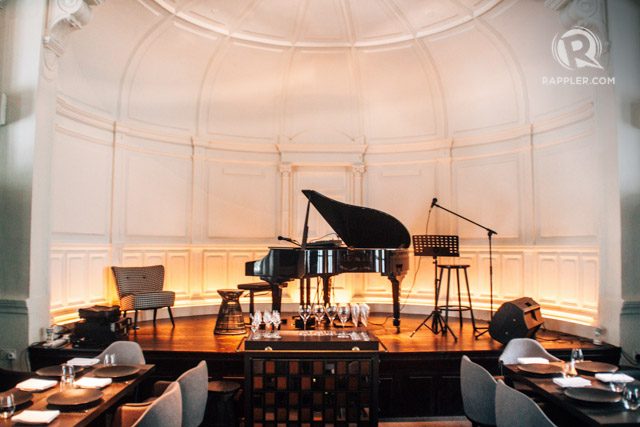
Sir Stamford Raffles, then Lieutenant-Governor of Bencoolen (now Bengkulu, Sumatra), laid the foundations for modern Singapore in 1819 when he negotiated with the local rulers to establish a trading post on the island.
The first 50 years saw Singapore growing rapidly. Infrastructure projects were carried out full-scale circa 1833 under the supervision of Irish architect George Drumgould Coleman. Government buildings, churches, and houses were built in an elegant colonial style.
Among those he built was a mansion for Scottish merchant John Maxwell. This was to become the future site where sovereign Singapore’s Parliament – with a majority from the ruling People’s Action Party – would first gather on December 8, 1965. Today, it has been refurbished as a multi-disciplinary arts center, The Arts House, which houses a restaurant named after Stamford Raffles’ beloved first wife, Olivia Cassivelaun Fancourt (OCF).
Trained in classical French cuisine, Chef Jonathan Koh helms OCF’s kitchen. At OCF, he serves omakase-style French set meals. His continental cuisine evokes old world colonial elegance albeit in a more comfortable jazzy, bistro-like setting. This La Carrot (Heirloom Carrots, Cheese Crémeux, Carrot Sorbet) was served to me as the entrée of an executive set lunch (S$38 per person).
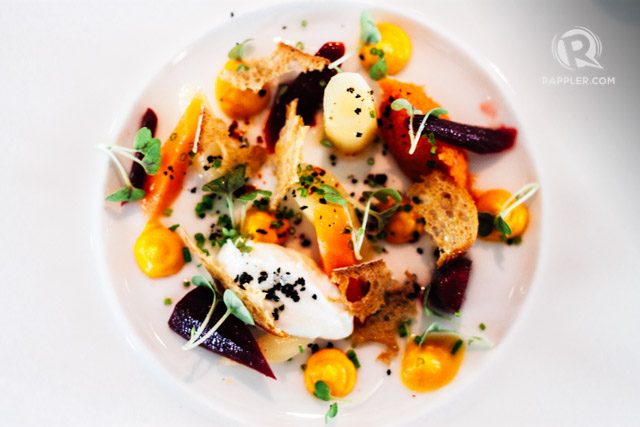
OCF (Olivia Cassivelaun Fancourt) – 1 Old Parliament Lane #01-02. Monday to Friday lunch (12 PM – 2 PM) and dinner (6 PM – 10 PM) service, Saturday for dinner only. +65 6333 9312
Shepherd’s Pie (Bread Street Kitchen)

The British imperialists who have passed on long ago have to thank Raffles’ cunning, which led him to lay the building blocks for the modern nation that we know. It became the capital of the Straits Settlements in 1832 that enjoyed unprecedented but unsurprising growth throughout 1873 to 1913.
Like many countries in the region, it suffered a blow from Japanese occupation during World War II. Soon afterwards, the Straits Settlements was no more, and Singapore became a Crown Colony from 1946 until 1959, when nationalist zeal led to a drive for self-governance.
The infamously fiery British chef Gordon Ramsay is the latest celebrity chef to set up shop at the posh and iconic Marina Bay Sands (MBS). Guests swear by the British-European comfort food served at his Bread Street Kitchen’s Singapore branch. The fare evokes humble street pubs at the center of the once mighty Empire, albeit in a chic setting.
The rustic Shepherd Pie (S$38) at Bread Street is a guest favorite. It’s pretty straightforward: braised lamb, onions and carrots is topped with a crust of potato purée and brioche crumbs. But it’s done as it should be: crisp on the outside and moist on the inside.
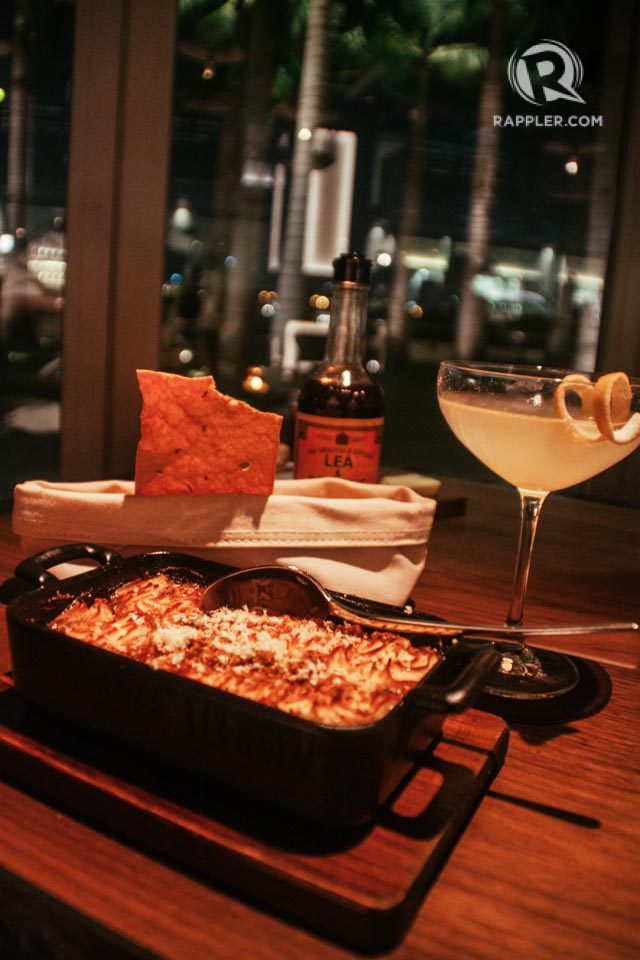
Ramsay’s reputation precedes him. To book a good seat at the MBS branch, you’ll need 14 weeks in advance. However, like many of the celebrity restaurants in the mall, solo diners can walk in and try their luck at the small tables or the bar.
Bread Street Kitchen – The Shoppes at Marina Bay Sands, #01-81, 2 Bayfront Ave. Daily lunch (11:30 AM – 5:30 PM), Sunday to Wednesday dinner (5:30 PM to 10 PM), Thursday to Saturday (5:30 PM to 12 AM). Bar: Sunday – Thursday (11:30 AM – 1 AM) Friday – Saturday (11:30 AM – 2 AM). Reservations: +65 6688 5665, BreadStreetKitchen.Reservations@MarinaBaySands.com, or via BookARestaurant.com
Coronation Chicken (Violet Oon Singapore)
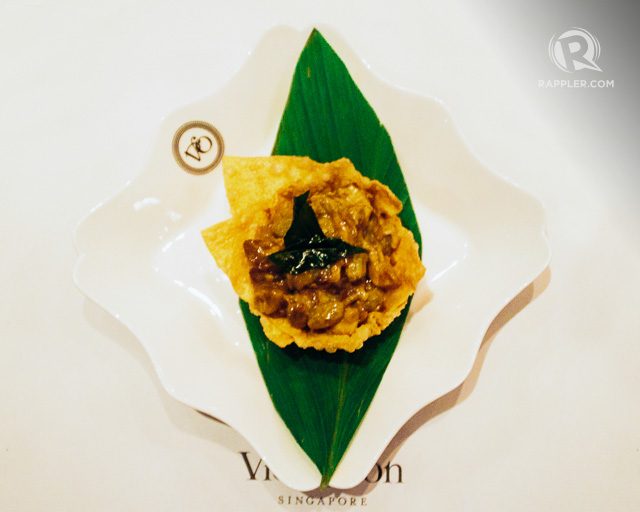
Chinese immigrants from Guangdong and Fujian first came to the Malay archipelago in the 10th century A.D. There were later, even bigger waves of seamen and traders who came in the 15th through 17th centuries, and never went back. Those who settled – even intermarrying with locals – called themselves Peranakan, which simply means “descendant” – distinguishing them from the newer arrivals. The men were called Baba, and the women, Nyonya.
Local culinary legend Violet Oon is a Nyonya. The former music critic first delved into her culinary heritage at 16 years old. Peranakan cooking, she notes, was one of the first to exemplify fusion cuisine – a “marriage” of “East and East” as well as “East and West.”
Her Coronation Chicken (S$13), she tells us, harks back to Singapore’s colonial times. Violet’s rendition of this English classic, created for Queen Elizabeth II’s 1959 coronation, is nestled in a wonton leaf cup and served as an hors d’oeuvre.
It’s both tart and tangy, owing to a creamy curry sauce and golden raisin chutney. Recall that the Peranakans were trustworthy British subjects. Violet Oon eloquently conveys this heritage in her Coronation Chicken and displays her Chinese roots through the amazingly crispy wonton cup.
Violet Oon Singapore – 881 Bukit Timah Rd. Tuesday to Friday lunch (12 PM – 2:30 PM) and dinner (6 PM – 10:30 PM), Saturday & Sunday breakfast (9 AM – 11:30 AM), lunch (11:30 AM – 2:30 PM), and dinner (6:00 PM – 10:30 PM), Closed on Mondays. +65 6468 5430
Char Kway Teow
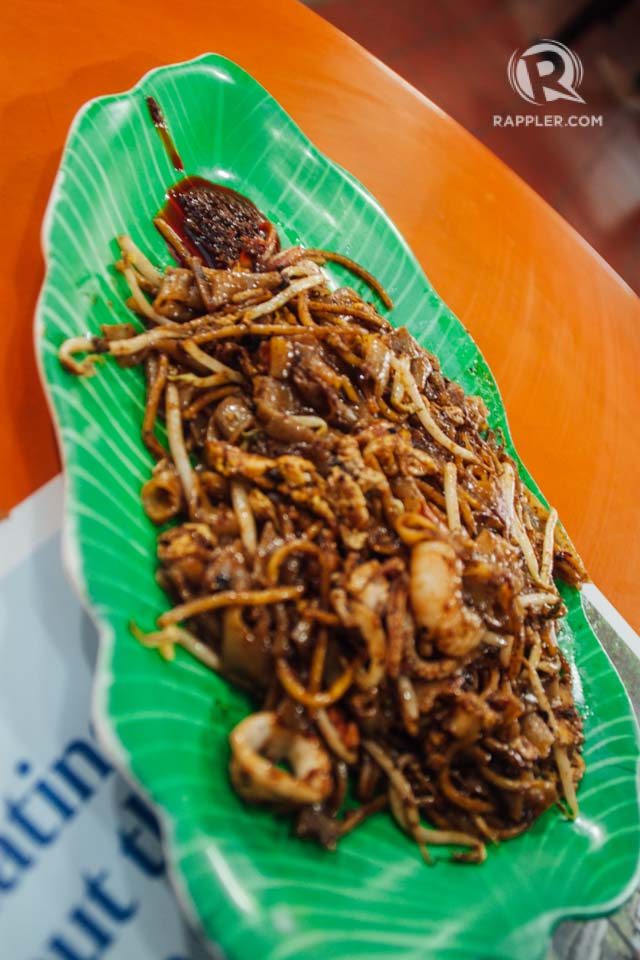
The Chinese dominate the contemporary social landscape of Singapore, comprising of 74.2% of its population. Today, the Hokkien and Teochew comprise the major Chinese dialect groups, and both have signature dishes. iEatiShootiPost.sg notes, “There is a local saying that goes ‘Teochew Kway Teow, Hokkien Mee,’ which essentially means that Kway Teow is the traditional staple of the Teochews while Hokkien Noodles is staple of the Hokkiens.”
Char Kway Teow, loosely translated to “stir-fried rice cake noodles” resemble tagliatelle but is stir-fried with dark soy sauce, shrimp paste (locally belachan), tamarind juice, bean sprouts, Chinese chives, lap cheong (Chinese sausages), and cockles. Before, pork lard was involved, but hawkers peddling kway teow became more health-conscious. They added more veggies and used vegetable oil instead of lard.
If you’re in the Chinatown area, the Fried Kway Teow stall (#01-53) at the Maxwell Food Centre cooks a mean Seafood Char Kway Teow (S$5).
Maxwell Food Centre – 1 Kadayanallur St. Daily 8AM – 10PM
Singapore Sling
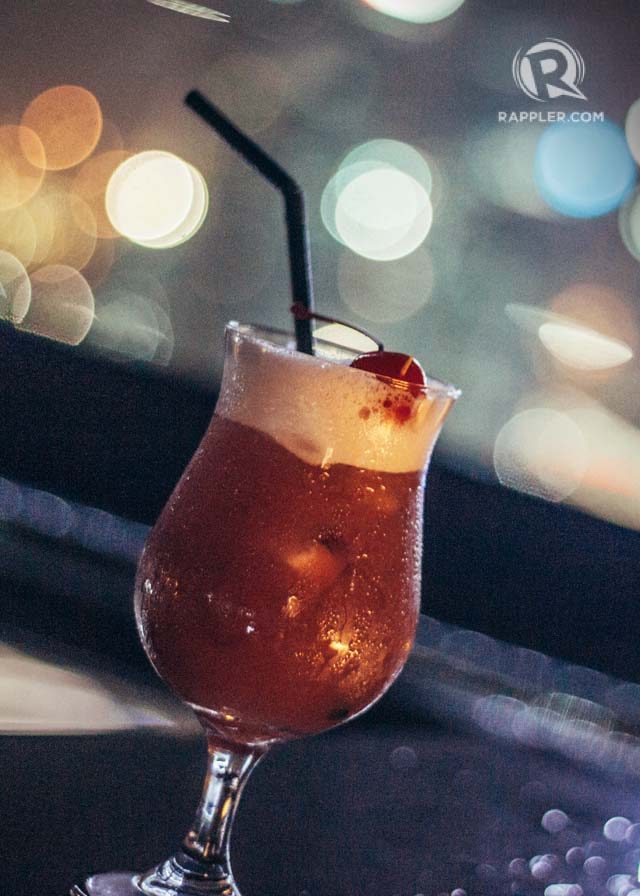
The Hainanese were another prominent Chinese subgroup that’s also made their mark on Singapore’s culinary culture. Today, they are credited for the creation of icons such as Chicken Rice and the Singapore Sling.
Ngiam Tong Boon, a Hainanese bartender at the Long Bar at the Raffles Hotel, invented the drink in 1915. The original recipe from the hotel consists of gin, cherry liqueur, Bénédictine, pomegranate juice and Sarawak pineapple juice.
Sip on this iconic cocktail while riding the Singapore Flyer (Singapore Sling Flight – S$69) with a panoramic view of the city’s downtown skyline.
Singapore Flyer – 30 Raffles Ave. Singapore Flight – Adult, S$33/Child, S$21. Daily 8:30 AM to 10:30 PM (last flight at 10 PM)
Roti Prata
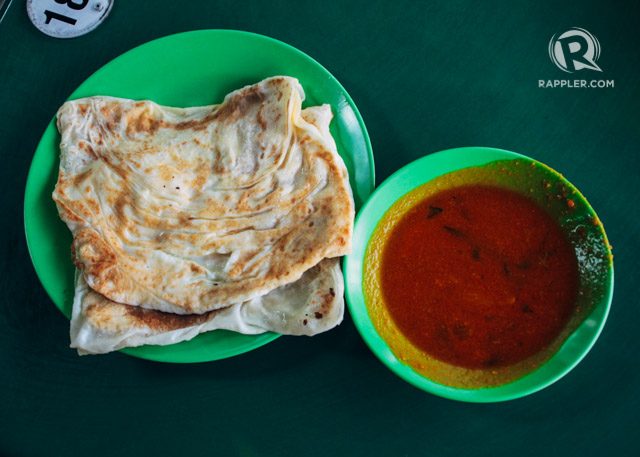
The Singaporean Indian community makes up 9.2% of the country’s population today, with the Tamils (usually from South India and northern Sri Lanka) comprising its majority. The local Indians come from diverse ethnic and cultural backgrounds; thus, the cuisine also varies. As a rule of thumb, expect dense aromas from a myriad of spices. North Indian cuisine tends to use yogurt, while South Indian cuisine often relies on coconut milk to cut through the spicy dishes.
Literally “flat bread,” the pancake-like Roti Prata is from India and Pakistan. They’re fluffy and soft, sometimes crisp on the outside, and locals love to dunk these in dhal (stew from lentil, pea, or other beans) or curry. Modern tastes let more eccentric pairings emerge – ranging from the savory (e.g. cheese) to the sweet (e.g. durian, ice cream).
I’ve done some research and asking around about the best Roti Prata in town, which directs me to the suburbs and the ethnic enclave of Little India. If you’re on a whirlwind itinerary, the nearest hawker centre probably won’t disappoint. Hajmeer Kwaja Muslim Food (#01-103) at Maxwell Food Centre gave me a decent Roti Prata fix (S$0.80 – plain, and around S$1.50 to 2.70 with cheese, egg, onion or combinations of these; minimum 2 orders).
Bak Kut Teh
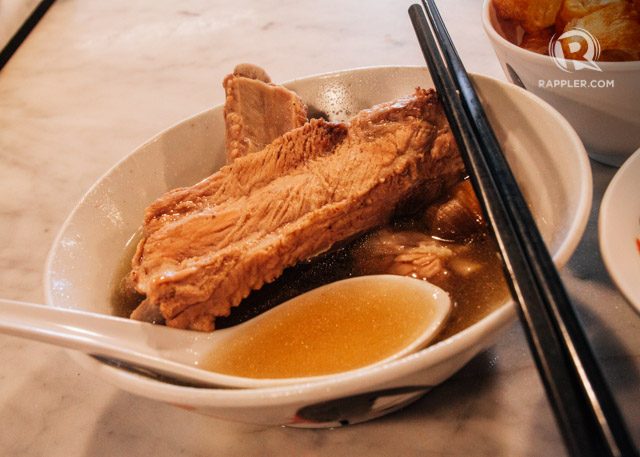
This Singaporean favorite, sometimes a morning jumpstart or a hangover cure, literally translates to pork bone tea. Although Bak Kut Teh can be found in both Singapore and Malaysia, local food blogger Dr. Leslie Tay of iEatiShootiPost.sg traces the name’s origin to the Clarke Quay area. Teochew and Hokkien stevedores had Bak Kut Teh as a morning energy boost of sorts. As Dr. Tay says, it’s a “dish born out of the docks.”
Commonly eaten with rice or noodles, Bak Kut Teh also goes with Chinese tea, usually Oolong or Pu Erh, thus the “tea” in the name. You can enjoy dipping chewy dough fritters (you tiao) in the soup as well.
It is served in two styles in the city: Teochew (from Teochew immigrants from the Chaoshan, region in China) and Klang (from Malaysia). The Teochew variety, which uses a clear, distinctively peppery broth with a mélange of spices, is arguably more famous.
The peppercorn immediately hits you, but it’s definitely not an assault to the senses. The meat is so tender; it falls off the bone easily. You don’t need to wonder why this is a go-to comfort dish among locals.
Song Fa Bak Kut Teh outlets around the Clarke Quay area whip up a reliable Teochew-style Pork Ribs Bak Kut Teh (S$7).
Song Fa Bah Kut Teh – 11 & 17 New Bridge Rd #01-01. Chinatown Point #01-04, 133 New Bridge Rd. The Seletar Mall #01-39/40/41 33 Sengkang West Ave. UE BizHub East (North Tower Office) 6 Changi Business Park Ave 1 #01-38
Ice Kachang
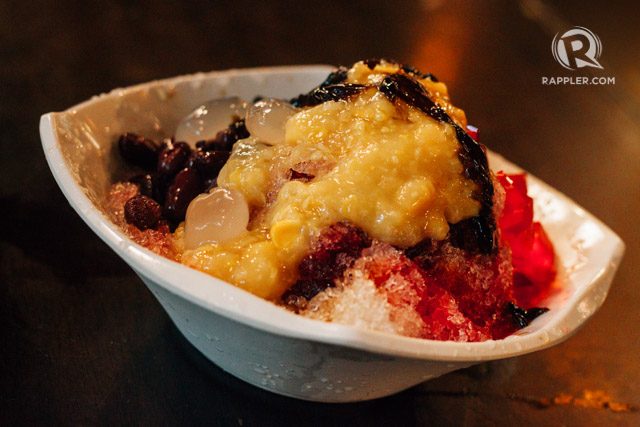
Ice Kachang (after the Malay name for red beans) was popular as a street treat in the middle of the 20th century – around the time of Singapore’s independence. Back then, they were ball-shaped and sold by pushcart drink vendors for additional income.
It is very similar to our Halo-Halo. Toppings for the shaved ice dessert Grass jelly, Jello, corn mash, red bean, and palm seed (atap chee, or in Filipino, kaong) are common to both desserts. Separating the wheat from the chaff is the same. Finely shaved ice and ingredient variety are marks of a good Ice Kachang.
Again, if you’re in Sentosa and having a lot of satay, it’s great to offset the meat’s richness with a sweet bowl of Ice Kachang (S$2.50, MFS Desserts), also found at Malaysian Food Street.
Chicken Rice
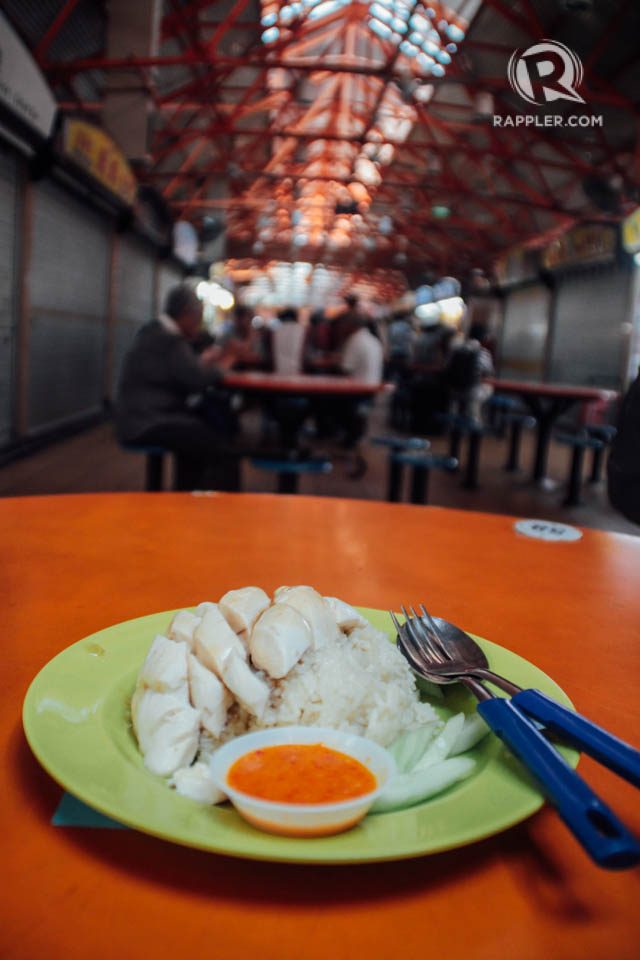
As a trading port throughout its history, Singapore harbored many entrepreneurial minds who peddled their wares on the streets – thus, “hawker.” This continued even until after the conclusion of World War II, when locals turned to hawking as unemployment had racked up. When industrialization efforts were at its height after independence in 1965, the demand for cheaper food was also high. Naturally, there was a discipline and hygiene situation; thus, the government set up complexes, called hawker centers.
The hawker center is quintessentially Singaporean – a microcosm of the cosmopolitan city where cultures and cuisines converge. It’s somewhat democratic: people of different faiths, and of social and ethnic backgrounds can mingle here. At these hawker centers, you can find the ubiquitous Chicken Rice, which contends for the honor of being a “national” dish.
In the 1850s, Hainanese people migrated to Singapore and brought in the beloved dish. The fowl that they had in Hainan Island, Wengcheng, is bony and not too fleshy. The Hainanese served it with oily rice and ground green chili dip. Singapore’s version, thus, evolved through taking in several influences – including the Cantonese twist of adding lime to the chili sauce.
Tian Tian Hainanese Chicken at Maxwell Food Centre (#01-10) serves a modern version of Chicken Rice. Recently, Tian Tian has gained some clout and good publicity through celebrity chefs and personalities Gordon Ramsay and Anthony Bourdain. So, the queues seem to never end.
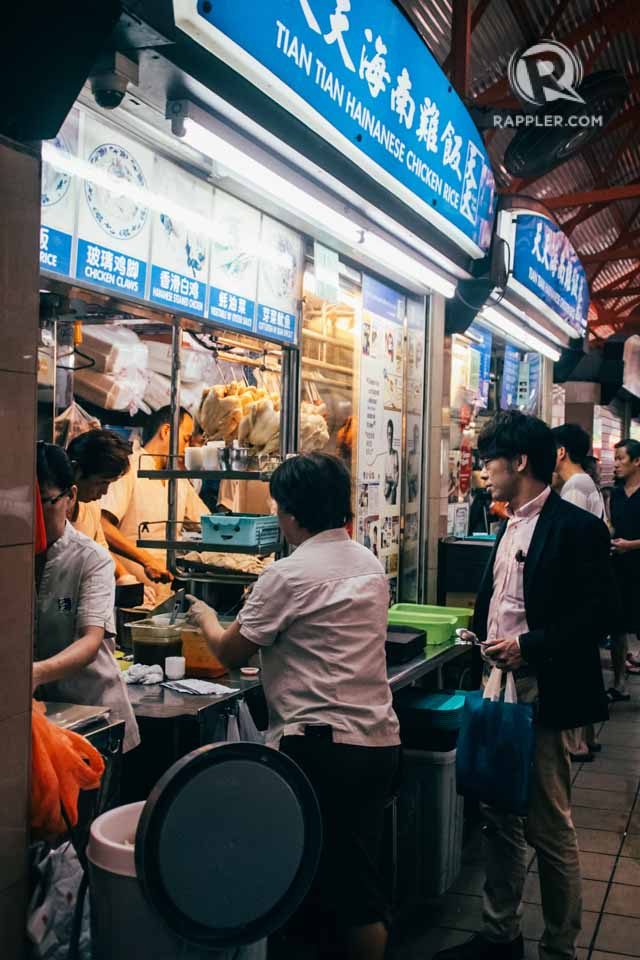
Tian Tian’s Chicken Rice lives up to the hype. The chicken is boiled and then dunked in a bath of ice water to help gelatinize the fat – neatly separating the skin from the flesh. The rice, boiled in chicken stock, pandan, ginger, and shallots, is incredibly aromatic, so you’ll probably enjoy eating it on its own. The chili dipping sauce adds a kick to the chicken’s savory flavor. Tian Tian uses garlic, chicken stock, chilies, and lime juice (instead of the usual vinegar) for their blend.
II
50 years later, things are shaking up
Fifty years after independence, we see a Singapore in transition.
The nation’s milestone also happens to be pivotal, after figurehead Lee Kuan Yew passed on last March 2015. In the hearts of many, the legacy he left was his realized vision of a prosperous Singapore. With its ultramodern landscape and high livability index, it’s the envy of many.
In an opinion piece, Monocle correspondent Jason Li describes a cultural upheaval in his birth country: “A growing number of Singaporeans are pausing to reflect and rethink about where we want to be heading as a country. More and more are eschewing once-respected 9-to-5 jobs to pursue their passions full-time – from fashion to literature and coffee.” Li adds, “The city is finally investing in a different kind of cultural capital and it is a change we should welcome.”
In an interview with The Guardian, Fabian Lua of Archiwalks, an entrepreneur himself, echoes this sentiment, “For a long time Singapore has been such a practical society, but the way I’m seeing change right now is that there are more and more people doing impractical things.” Innovation expert Scott Anthony explains in the Harvard Business Review, “Singapore’s phenomenal development over the past 50 years means many of its citizens are sufficiently well off to take the entrepreneurial plunge without truly risking everything.”
Out of affluence or necessity, many Singaporeans have left the Little Red Dot for work and study. This exposed them to other cultures whose food scenes pique their interest. Some of them decide to bring their experiences abroad back home, churning the melting pot that is Singapore even more. From Third Wave coffee companies, to “dude food” joints, to artisanal hawker stalls, the cultural change reflects even on the local gastronomy.
But many locals, especially the old erfolks, are anxious about the rapid change. Old neighborhoods become gentrified with a proliferation of hip restaurants and some traditional, family-run food businesses ceased operations. So even the nation’s future – its hopes and dreams – can be gleaned from its food: through taste or even just the place where it’s served.
As hip cafés and restaurants proliferate throughout Singapore, does time simply wait for no one? Or is Singapore going to be the renaissance city of people’s dreams?
Farm Chicken Supreme (Sky on 57)
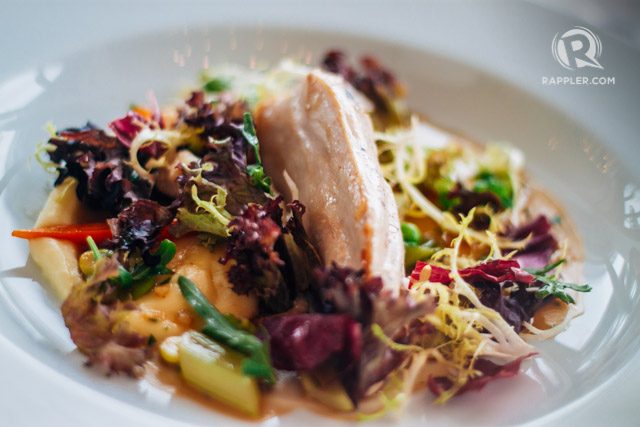
Singaporeans leaving to study or work overseas have been increasing in recent years. “[G]iven the effects of globalisation, increased mobility of people around the world and Singapore’s status as a city state, the trend is inevitable,” Amanda Lee of Today notes. Beyond the Little Red Dot, there are adventures and greener pastures in far more vast spaces.
Two decades ago, Singaporeans moving out wasn’t unheard of: Justin Quek, “Singapore’s favorite culinary son” wanted to travel. After culinary school as well as hotel stints in Singapore and Bangkok, he took a leap of faith to spend his life’s savings to train in some of Europe’s top kitchens. He took what he learned and set up restaurants under his brand in Hong Kong, Shanghai, and Taiwan.
The year 2010 saw Chef Justin Quek’s return with Sky on 57 opening at the Marina Bay Sands. With vistas of Singapore’s skyscrapers and old shophouses, Sky on 57 conveys the story of both Quek’s flight from home and his homecoming.
This deceptively simple pan roasted Farm Chicken Supreme (main course, Seasonal Set Lunch S$50++) for instance, has the finesse of haute cuisine techniques learned from great French kitchens. Quek, however, recognizes that drawing from his Chinese heritage with a hint of Sichuan pepper can transform the dish.
Sky on 57 – Tower 1, Marina Bay Sands, 10 Bayfront Ave. Monday to Friday breakfast (7 AM – 10:30 AM), lunch (12 PM – 2:30 PM), and high tea (2:30 PM – 5 PM). Saturday, Sunday & Public Holidays breakfast (7:00am – 11:00am), lunch (12:15 PM – 2:30 PM), and high tea (3 PM – 5PM). Daily dinner (6:00pm – 10:30 PM). +65 6688 8857
Flat White and Cinnamon Pound Cake (CSHH Coffee Bar)
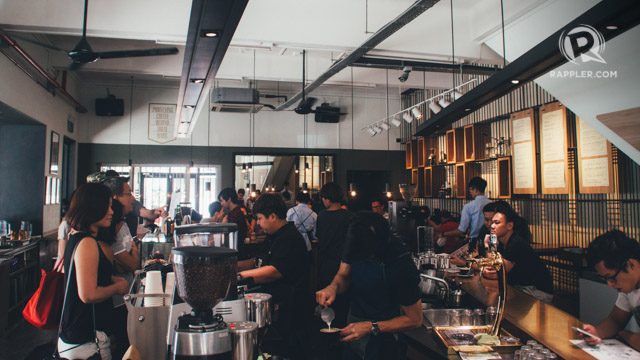
Tucked in the middle of Jalan Besar, Chye Seng Huat Hardware (CSHH) is a bit off the beaten track – away from the sparkly malls and into an eclectic and historic neighborhood. It’s also the flagship café of Papa Palheta, one of the pioneering coffee companies behind Singapore growth as a café culture on a par with the likes of Melbourne.
The influx of Third Wave or specialty coffee shops like CSHH can be said to be a spinoff of Singaporeans relocating abroad for work or study. Harry Grover of Common Man Coffee Roasters, another local coffee company, told the Sydney Morning Herald, “Many of the new generation of Singaporeans have studied in Sydney or Melbourne, and they’ve come back home and thought, ‘I want to have the same quality.'”
Founded by an ex-banker, “[Papa Palheta’s] concept has become a benchmark in a city better known for large malls than independent outfits and encourages a new type of retail,” says a feature in Monocle’s April 2014 issue. In Singapore, you don’t commonly hear businesses wanting to keep it small to be tight-knit with the community.
At CSHH, I asked for my flat white (S$5.50), a velvety espresso-based drink that originated from Australia (or New Zealand – depending on who you ask), to be made with shots pulled from their Terra Firma Blend. Made of specialty-grade beans from Brazil, Guatemala, and Ethiopia, it makes a bright and sweet cup with notes of citrus and nuts. It’s wonderful with their toasted Cinammon Pound Cake (S$8).

CSHH Coffee Bar & Papa Palheta, Chye Seng Huat Hardware. 150 Tyrwhitt Rd. Tuesday to Friday (9 AM – 7 PM), Saturday and Sunday (9 AM – 10 PM), Closed on Mondays
Tau Sar Pau (Forty Hands)

Tiong Bahru is one of the first public housing estates in Singapore. Built back in the ’30s, the art deco buildings that line the streets are quaint but elegant. The neighborhood is a perfect testament to why historical buildings must be given a new lease on life.
On the ground level though, indie cafés and niche shops have proliferated. The cool cats and creative types come to hang here, and everything seems to be swell.
Forty Hands, on buzzing Yong Siak Street, is one of those leading the charge. The café claims to serve the best azuki-filed pastries on the island:Tau Sar Pau (S$2.50) – steamed red bean buns, as the Teochew name suggests. Think: a cross between those Korean grocery-bought fish-shaped ice cream sandwiches, and siopao. A poster at the back of the café cheekily exclaims, “Tau Sar Pau Glory, Hot Buns Make Me Horny,” attesting that crowds lust for these pillowy buns – served in yet another Third Wave coffee shop, no less.
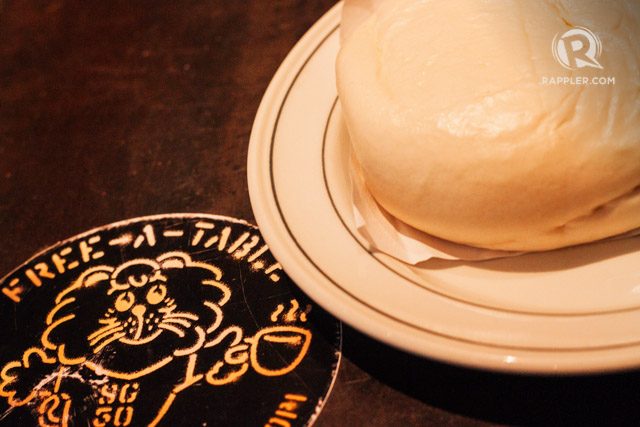
Places like Yong Siak Street weren’t always boisterous, though. It’s layered with history: from being a graveyard, to a posh housing estate, to a retirement hub of sorts. However, the newer establishments brought rents up and “pushed out the old-time favorites,” according to Today. It’s convenient to blame the hipsters for its woes, but it’s far more complicated than that.
Gentrification can’t be solely blamed for traditional haunts fading away. Today also lists other factors: rising rent across Singapore and the lack of successors to family businesses, among others. Change is inevitable and the old must give way, say some of the neighborhood’s mainstays. They say that the newcomers have revitalized these old neighborhoods, and historical structures are, at the very least, conserved.
Forty Hands – 78 Yong Siak Street, #01-12. Tuesday to Sunday (8 AM – 7 PM), Closed on Mondays
Purple and Kyoho Daisy (2am Dessert Bar)
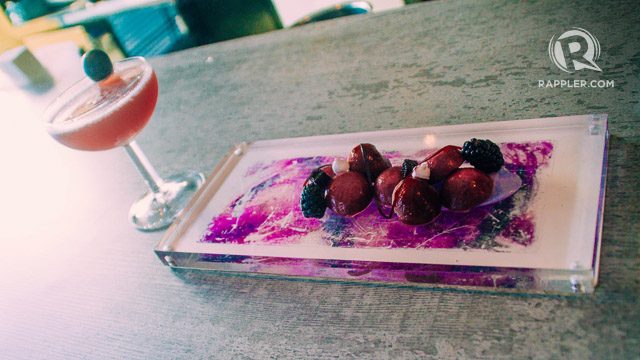
In another chill part of town, another globetrotting Singaporean culinary legend has set up shop. Twice named Asia’s Best Pastry Chef, Janice Wong didn’t originally intend to be a dessert master until she had a taste of Melbourne. She studied in Le Cordon Bleu, no less, and worked with the likes of renowned chocolatier Oriol Balaguer and pâtissier Pierre Hermé since then.
Frustrated that “desserts were never the highlight of a meal,” Wong opened 2am: dessertbar at tranquil Holland Village. Here, upmarket and Bohemian enterprises have also set up shop – especially at the expat enclave, Chip Bee Gardens, on the other side of Holland Road.
Janice Wong’s answer to rapid modernization in these quiet neighborhoods: “Singapore is very progressive, so everything needs to constantly move forward,” she tells the Huffington Post. “[We] still have a respect for our traditional recipes, so our desserts are based on classic techniques, then plated in a very progressive way to be pleasing to the eye,” she adds, pointing out that some of the ice cream at 2am incorporates local flavors.
Patrons swear by the Chocolate H20 (S$20) or Wong’s signature Cassis Plum (S$24) at 2am, but the other desserts are equally stellar. Feast your eyes on this Purple (S$17) – purple potato purée, blackberry parfait, leather, lavender marshmallows, and fruits of the forest sorbet – paired with a Kyoho Daisy (S$18) cocktail.
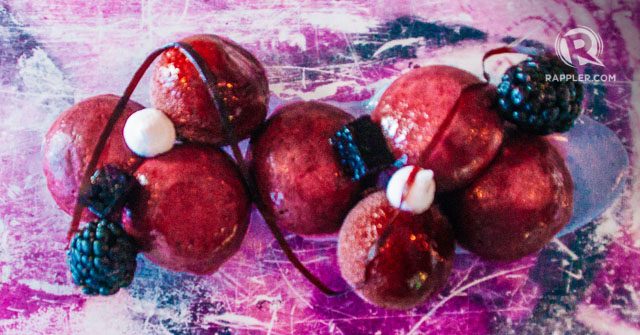
2am: dessertbar – 21A Lorong Liput, Holland Village. Tuesday to Friday (3 PM – 2 AM), Saturday to Sunday, open for brunch (11 AM – 2 AM), Closed on Mondays. +65 6291 9727
Communal dishes: Falafel Lettuce Cups, Hot Skillet Prawns, Salad Shirazi, Artichoke Fried Chicken, and Wood Roasted Pork Ribs (Artichoke)
If you need some proof that things in Singapore are shaking up with a burgeoning creative scene, then visit Chef Bjorn Shen’s Artichoke.
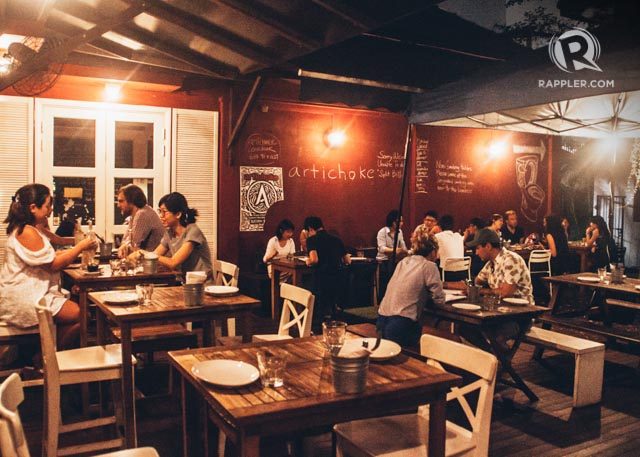
Chef Bjorn’s story is familiar, as he also took a management route at university in Australia – except that he took it to help him fulfill his dream, amidst a trend among Singaporean yuppies leaving the corporate world to pursue their passions. He’s up-front about his rebellious streak, which reflects on Artichoke and its Mediterranean-inspired dishes.
When it comes to looks, the place, with its Shepard Fairey-like posters adorning the walls and its New Orleans bayou-like setting, is kind of a misfit in the funky but polished arts and design district of Bras Basah and Bugis. But Artichoke’s “artisanal, Middle Eastern dude food,” doesn’t scrimp on imagination.
If Daft Punk had a culinary equivalent (at least among the food I’ve tasted in my entire life), then this would be it. It’s sometimes ridiculous with a lot of rock ‘n’ roll going on, but it delivers the goods! The servings are ample for passing around the table – befitting Singapore’s food culture – and the dishes are big and bold – just like the rich Middle Eastern fare it was inspired by.
Take their Falafel Lettuce Cups (S$18), smothered in Big Mac sauce, for example.
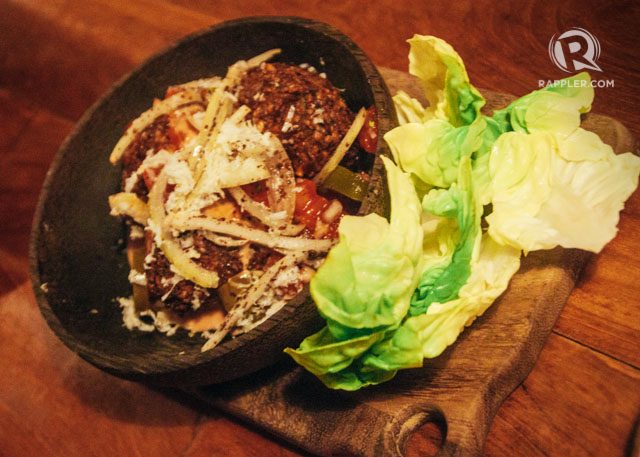
Their signature Artichoke Fried Chicken (served only at brunch, S$24), glazed with honey lemon – with paprika fries, tahini coleslaw, Lebanese pickles, toum garlic whip, and green harissa – is unpretentious but edgy. Their Hot Skillet Prawns (S$36), swimming in cream, has a North African flair to it with the green chili harissa. The Wood Roasted Pork Ribs (S$32) is basted in coffee-date BBQ sauce. If everything proves to be overwhelming for you, the Salad Shirazi (S$14) can be a refreshing side dish albeit brilliant on its own.

Artichoke – 161 Middle Road, Sculpture Square. Tuesday to Friday dinner (6:30 PM – 9:45 PM), Saturday brunch (11:30 AM – 2:45 PM) and dinner (6:30 PM – 9:45 PM), Sunday brunch (11:30 AM – 2:45 PM), Closed on Mondays. +65 6336 6949
Pork Belly (Immanuel French Kitchen)
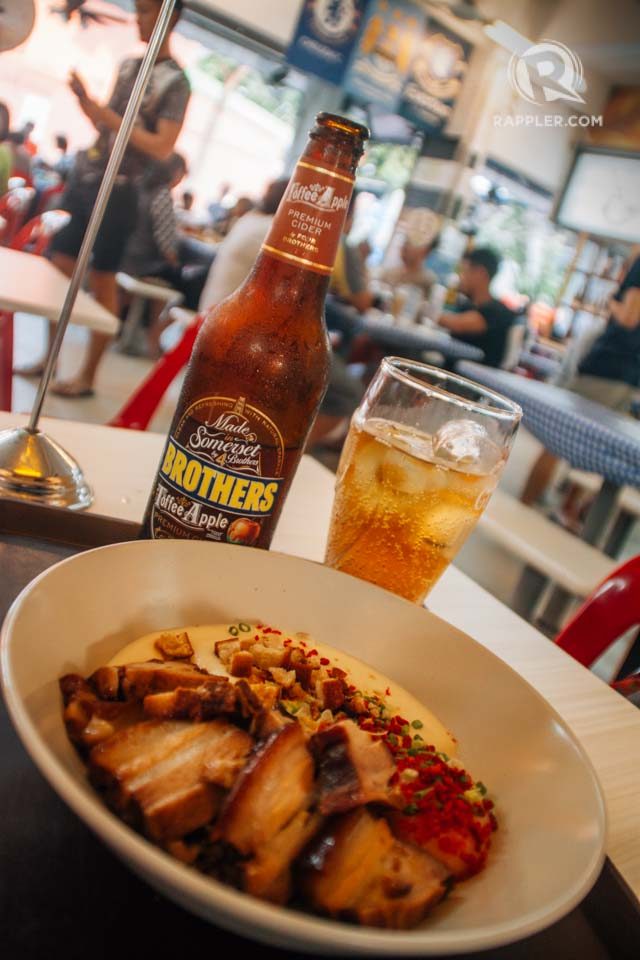
Singapore’s future rests on an emerging generation of young creative types and entrepreneurs. Twenty-something Immanuel Tee is one of them. Having worked in reputable kitchens in the city-state and abroad, he’s armed with a formidable skill set. He went his own way and set up the classic French food stall Immanuel French Kitchen in the “logic-defying” Salut Kopitiam in Bukit Merah Lane 1 – hole-in-the-wall, hawker vibes, but posh by most standards. His neighbors sell craft beers and ciders, chicken wings, and the like, so you get the point.
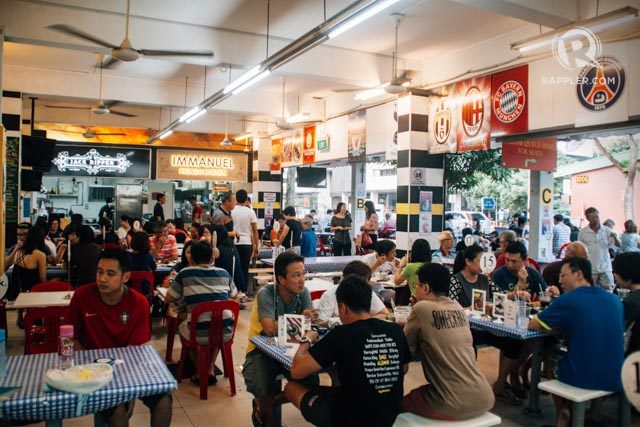
The kakuni-style Pork Belly (S$16.90) is evidence of Tee’s promise. The braised pork belly is melt-in-your-mouth goodness atop a bed of buttery potato foam with milky onsen egg and duxelle mushrooms. It’s a symphony of textures – pocket-friendly and gives you bang for your buck.
Young chefs like Immanuel Tee show that Singapore’s future might rest on its promising youth who persevere in creative vocations. Whether this shift towards a millennial ethos will prove to be for the better, only time can tell. But it’s a great start. As Singapore joins other great cosmopolitan cities in the world, it’s evolving, clearly moving in a beautiful – and delicious – direction.
Immanuel French Kitchen, Salut Kopitiam. 119 Bukit Merah Lane 1 #01-40. Tuesday to Sunday (12:00 PM – 2:30 PM, 6:00 PM – 9:30 PM). +65 9297 3285
– Rappler.com
Note: The writer was part of a recent trip to Singapore sponsored by the Singapore Tourism Board.
Paolo Abad is a film/television editor and motion graphic designer. He is also a self-confessed concert junkie. Follow his Instagram for live music @outoftunephoto
Planning that trip to Singapore soon? Check out our Agoda coupons for the best deals on travel.
Add a comment
How does this make you feel?
There are no comments yet. Add your comment to start the conversation.